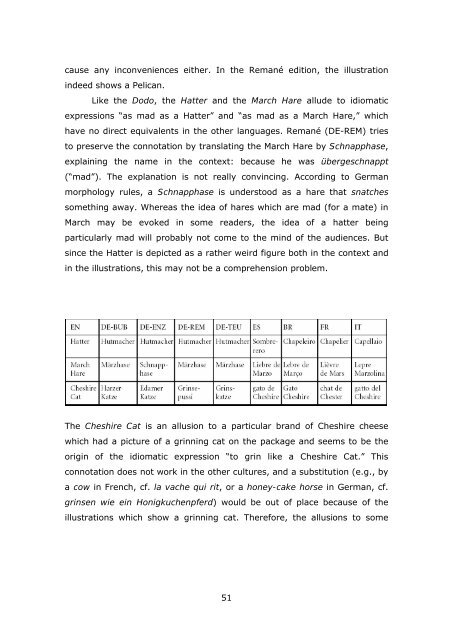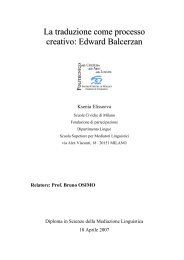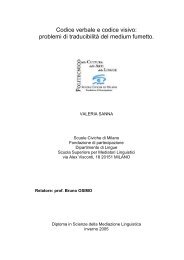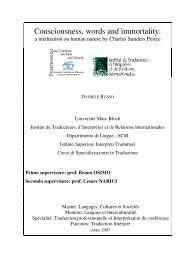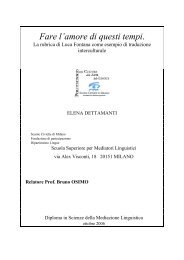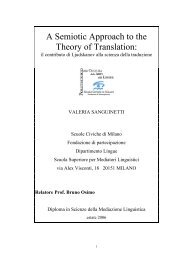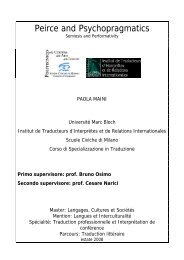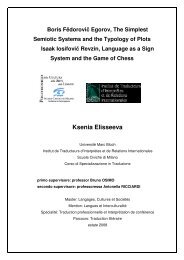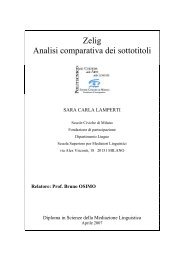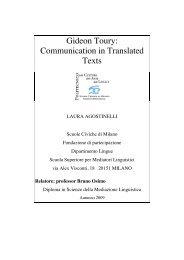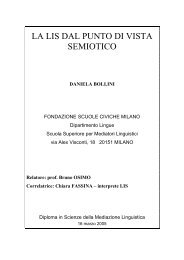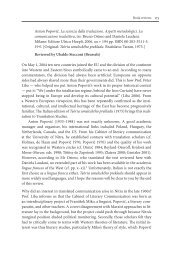Alice in Wonderland - Bruno Osimo, traduzioni, semiotica della ...
Alice in Wonderland - Bruno Osimo, traduzioni, semiotica della ...
Alice in Wonderland - Bruno Osimo, traduzioni, semiotica della ...
You also want an ePaper? Increase the reach of your titles
YUMPU automatically turns print PDFs into web optimized ePapers that Google loves.
cause any <strong>in</strong>conveniences either. In the Remané edition, the illustration<br />
<strong>in</strong>deed shows a Pelican.<br />
Like the Dodo, the Hatter and the March Hare allude to idiomatic<br />
expressions “as mad as a Hatter” and “as mad as a March Hare,” which<br />
have no direct equivalents <strong>in</strong> the other languages. Remané (DE-REM) tries<br />
to preserve the connotation by translat<strong>in</strong>g the March Hare by Schnapphase,<br />
expla<strong>in</strong><strong>in</strong>g the name <strong>in</strong> the context: because he was übergeschnappt<br />
(“mad”). The explanation is not really conv<strong>in</strong>c<strong>in</strong>g. Accord<strong>in</strong>g to German<br />
morphology rules, a Schnapphase is understood as a hare that snatches<br />
someth<strong>in</strong>g away. Whereas the idea of hares which are mad (for a mate) <strong>in</strong><br />
March may be evoked <strong>in</strong> some readers, the idea of a hatter be<strong>in</strong>g<br />
particularly mad will probably not come to the m<strong>in</strong>d of the audiences. But<br />
s<strong>in</strong>ce the Hatter is depicted as a rather weird figure both <strong>in</strong> the context and<br />
<strong>in</strong> the illustrations, this may not be a comprehension problem.<br />
The Cheshire Cat is an allusion to a particular brand of Cheshire cheese<br />
which had a picture of a gr<strong>in</strong>n<strong>in</strong>g cat on the package and seems to be the<br />
orig<strong>in</strong> of the idiomatic expression “to gr<strong>in</strong> like a Cheshire Cat.” This<br />
connotation does not work <strong>in</strong> the other cultures, and a substitution (e.g., by<br />
a cow <strong>in</strong> French, cf. la vache qui rit, or a honey-cake horse <strong>in</strong> German, cf.<br />
gr<strong>in</strong>sen wie e<strong>in</strong> Honigkuchenpferd) would be out of place because of the<br />
illustrations which show a gr<strong>in</strong>n<strong>in</strong>g cat. Therefore, the allusions to some<br />
51


